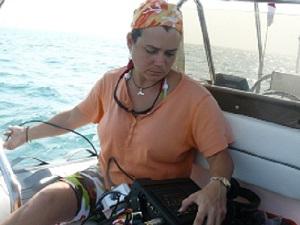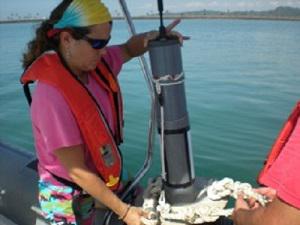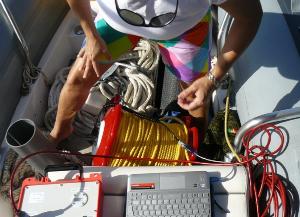Inez Campbell
The aim of this study is to assess the effects of shipping noise caused by vessels on the distribution and diversity of cetaceans at both sides of the Panama Canal.

Recording with C55-FR2.
Marine mammal distribution is probably mainly determined by prey availability; and prey distribution in turn is closely linked to the bathymetry and oceanographic characteristics. The Panama coasts offer a variety of topography types and seasonal habitats, and therefore it is expected that it may offer a diverse group of cetaceans. Unfortunately, there is not baseline data that contains this information for both of Panama’s coast, and therefore a mathematical prediction is needed for the study. The use of environmental variable to create Predictive Models of cetacean distributions has been widely documented by several authors (Hui 1979, Selzer and Payne 1988, Guisan and Zimmermann 2000, Waring et al. 2001, Hastie et al. 2005, Ferguson et al. 2006, Kaschner et al. 2006, Freitas 2008). By using depth, slopes, water productivity, and reported sightings, a prediction model defines an expected composition and distribution of species for that particular area; in this case, the diversity that should be found in the areas surrounding the Panama Canal entrances.

Stationary Hydrophone before deployment.
The main objective of this study is to assess the effects of shipping noise caused by vessels transiting through the Panama Canal on the distribution and abundance of cetaceans at both sides of the Isthmus of Panama. It has been difficult to document an accurate way to measure the reaction to noise disturbance, because there have not been controlled experiments while conducting studies in the wild. However, there are many studies on the effect of different anthropogenic sounds on the behaviour of cetaceans in general (Greene and Moore 1995, Richardson et al. 1995, Lesage and Barrette 1999, Croll et al. 2001, Erbe 2002, Evans 2003, Barlow and Gisiner 2006, Taubitz 2007, Holt et al. 2009). Commonly, the reactions have been defined as cessation of the activity but also depending on the activity taking place by at the moment of disturbance. For example, for dolphins: upon resting, they avoid boats; upon foraging, they ignore boats, and upon socializing, dolphins may approach boats. Overall, noise from human activities, whether shipping noise or construction noise, may cause pronounced short-term behavioural reactions and temporary local displacement of certain species of cetaceans (Richardson et al. 1995).

Other equipment used Fiobuoy.
The methodology involves the use of stationary hydrophones (underwater recorders) and single deployment hydrophones, which will cover two different areas sampled using point transects. An area will make recordings of delphinid sounds in a 24 hr cycle, while another area will be conducted only during daylight hours, by combining visual survey methods with passive acoustics.
Although the primary objective of this study does not constitute a complete assessment of cetacean populations throughout all Panamanian waters, it will contribute strongly to the basic knowledge of coastal cetacean populations based on the methodology. This is the first study of its kind in Panamanian waters, and its outcome is two fold: it will be a contribution to the greater library of studies conducted to improve the low-noise technology in the manufacture of ship propellers; and, it will represent a conservation tool for a better management of cetaceans in Panamanian waters.